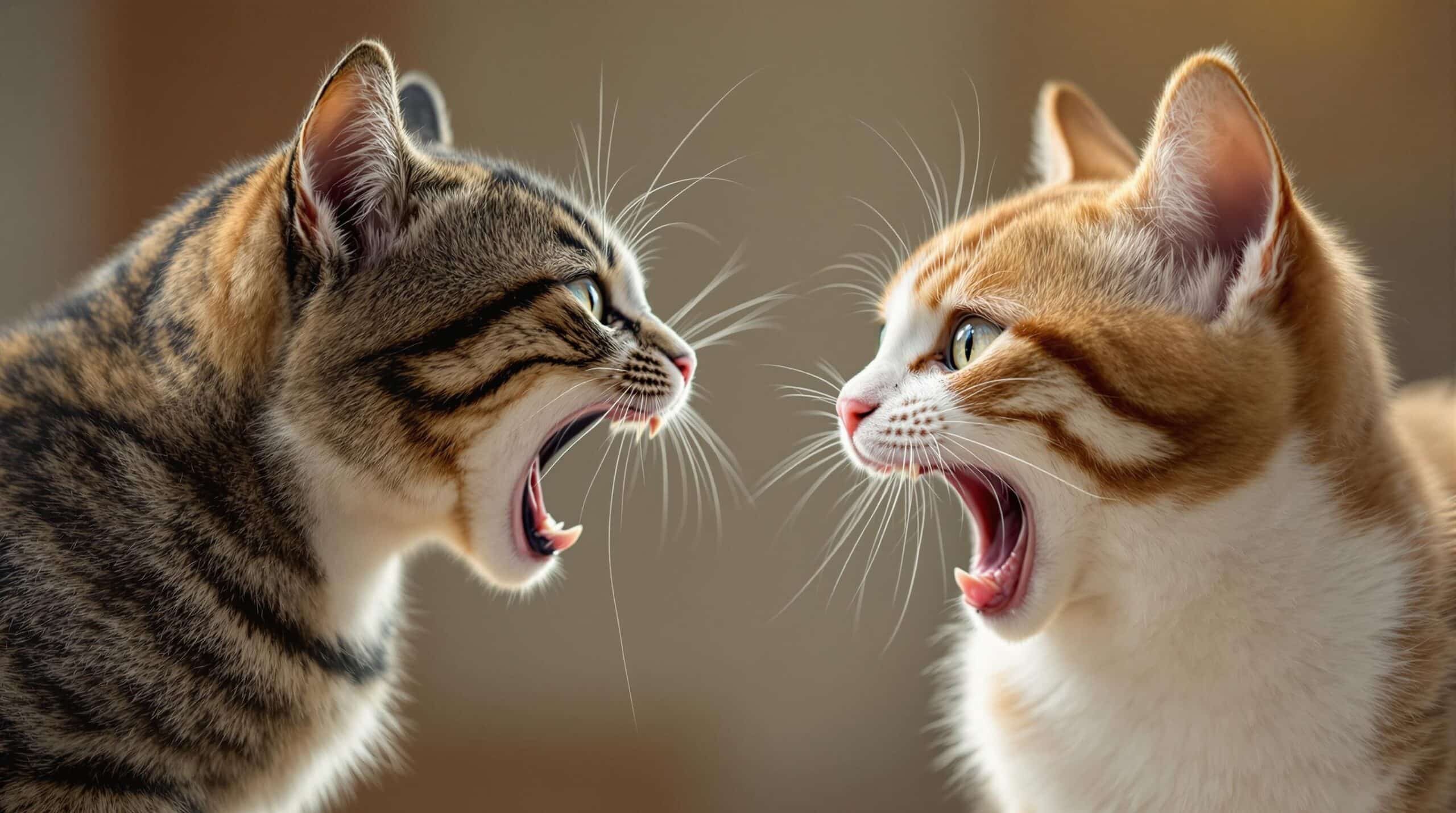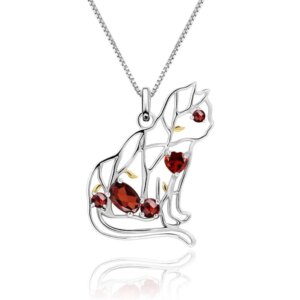Cats fighting sounds can be distressing for both pets and their owners. This guide explores the various vocalizations cats make during fights, their meanings, and practical tips for managing and preventing aggressive behavior. By understanding these sounds, you can create a more harmonious environment for your feline friends and ensure their well-being.
Types of Cat Fighting Sounds
Cat Hissing Sounds
At Cat Karma Creations, we understand that cat hissing sounds are sharp, rapid expulsions of air that often indicate a defensive or fear-based response. These sounds are typically heard when a cat feels threatened or cornered. Hissing is a clear sign that the cat wants to avoid conflict and is trying to communicate its discomfort or fear.
Behavioral Context: Defensive, fear-based
Common Causes: Feeling threatened, territorial disputes
Management Tips: Provide safe spaces, use calming pheromones
Cat Growling Noises
Cat growling noises are low, rumbling sounds that often signify aggression or a threatening stance. These sounds can be heard when a cat is trying to assert dominance or express fear. Growling is a clear warning that the cat is not in a playful mood and should be approached with caution.
Behavioral Context: Aggressive, threatening
Common Causes: Dominance, fear
Management Tips: Identify and remove triggers, consult a vet
Cat Yowling Sounds
Cat yowling sounds are long, drawn-out vocalizations that often indicate distress or pain. These sounds can be heard during fights and are a clear sign that the cat is experiencing significant discomfort. Yowling can also occur during mating or when a cat is in pain.
Behavioral Context: Distress, pain
Common Causes: Mating, pain, distress
Management Tips: Address underlying issues, provide comfort
Cat Meowing Loudly
Cat meowing loudly is a high-pitched, repetitive sound that cats use to communicate various needs. This vocalization can be heard when a cat is seeking attention, feeling lonely, or experiencing distress. Loud meowing is a way for cats to express their needs and can be a sign of emotional or physical discomfort.
Behavioral Context: Attention-seeking, communication
Common Causes: Hunger, loneliness, distress
Management Tips: Ensure basic needs are met, offer attention and playtime
Common Reasons for Cat Fighting
Territorial Disputes
Cats are territorial animals, and disputes over territory are a common cause of fights. These disputes can occur both indoors and outdoors, and they often involve marking territory, vocalizations, and physical confrontations. Understanding and managing territorial behavior is crucial for preventing cat fights.
Dominance Issues
Dominance issues are another common reason for cat fights. Cats establish a hierarchy within their social groups, and conflicts can arise when one cat tries to assert dominance over another. These issues are more prevalent in multi-cat households and can lead to ongoing tension and aggression.
Fear and Anxiety
Fear and anxiety can trigger aggressive behavior in cats. When a cat feels threatened or anxious, it may become defensive and lash out. Common triggers include changes in the environment, the presence of unfamiliar animals, or perceived threats from other household members.
Mating Behavior
Mating behavior is a significant factor in cat fighting, especially among unneutered males. During mating season, male cats may become more aggressive and territorial, leading to conflicts with other males. Female cats can also become more vocal and may display aggressive behavior during this time.
Preventing and Managing Cat Fights
Creating a Safe Environment
Creating a safe and stress-free environment is essential for preventing cat fights. Provide each cat with its own space, including separate feeding areas, litter boxes, and sleeping spots. Use calming pheromones and environmental enrichment to reduce stress and anxiety. If you need any assistance, feel free to contact us at info@catkarmacreations.com.
Behavioral Training Techniques
Behavioral training techniques can help reduce aggressive behavior in cats. Positive reinforcement, such as treats and praise, can encourage desired behaviors and discourage aggression. Consistency and patience are key when implementing training techniques.
Consulting a Veterinarian
If your cat is displaying aggressive behavior, it’s important to consult a veterinarian to rule out any underlying medical issues. Conditions such as pain, infections, and hormonal imbalances can contribute to aggression and should be addressed promptly. You can reach us at (800) 343-1604 for more information.
Environmental Enrichment
Environmental enrichment is crucial for keeping cats mentally and physically stimulated. Provide toys, scratching posts, and interactive activities to keep your cats engaged and reduce boredom. A stimulating environment can help prevent conflicts and promote a harmonious household.
When to Seek Professional Help
Persistent Aggression
If your cats continue to display aggressive behavior despite your best efforts, it may be time to seek professional help. A certified animal behaviorist can provide specialized advice and strategies for managing and resolving aggression. For more tips and support, visit our website at Cat Karma Creations.
Injury or Illness
If your cat is injured or showing signs of illness, it’s important to seek veterinary care immediately. Injuries can worsen if left untreated, and underlying medical issues may need to be addressed to prevent further aggression.
Behavioral Changes
Sudden or significant changes in your cat’s behavior can be a sign of underlying issues. If you notice changes in your cat’s eating habits, activity levels, or social interactions, it’s important to consult a professional for guidance.
Multi-Cat Household Challenges
Managing a multi-cat household can be challenging, especially when it comes to preventing and resolving conflicts. A professional can provide tailored advice and strategies for maintaining peace and harmony in your home. Follow us on Facebook and Instagram for more tips and updates.
Comparison Table: Cat Fighting Sounds
| Feature | Cat Hissing | Cat Growling | Cat Yowling | Cat Meowing |
|---|---|---|---|---|
| Sound Description | Sharp, rapid expulsion of air | Low, rumbling sound | Long, drawn-out vocalization | High-pitched, repetitive sound |
| Behavioral Context | Defensive, fear-based | Aggressive, threatening | Distress, pain | Attention-seeking, communication |
| Common Causes | Feeling threatened, territorial disputes | Dominance, fear | Mating, pain, distress | Hunger, loneliness, distress |
| Management Tips | Provide safe spaces, use calming pheromones | Identify and remove triggers, consult a vet | Address underlying issues, provide comfort | Ensure basic needs are met, offer attention and playtime |
Key Tips for Managing Cat Fighting Sounds
- Understanding the different types of cat vocalizations and their meanings
- Identifying the common triggers of cat aggression and fighting
- Creating a safe and stress-free environment for multi-cat households
- Using behavioral training techniques to reduce aggressive behavior
- Consulting a veterinarian for medical issues that may contribute to aggression
- Implementing environmental enrichment to keep cats mentally and physically stimulated
Popular Quote
“A cat has claws at the end of its paws, but a man has words at the end of his tongue.” — Unknown
Statistical Fact
According to the American Veterinary Medical Association, approximately 30% of cats in multi-cat households exhibit aggressive behavior towards other cats. This statistic underscores the importance of understanding and managing cat fighting sounds to maintain a harmonious home environment. (Source: American Veterinary Medical Association)
Three Tips for Managing Cat Fighting Sounds
- Provide Vertical Space: Cats love to climb and perch, so adding vertical spaces like cat trees and shelves can help reduce territorial disputes and provide each cat with its own territory.
- Use Calming Aids: Consider using calming aids such as Feliway diffusers or calming sprays to reduce stress and anxiety in your cats. These products can help create a more relaxed atmosphere in your home.
- Gradual Introduction: If you are introducing a new cat to your household, do so gradually. Keep the new cat in a separate room initially and allow the cats to get used to each other’s scent before face-to-face interactions.
Popular Questions
- What are the most common reasons for cat fighting? The most common reasons for cat fighting include territorial disputes, dominance issues, fear and anxiety, and mating behavior.
- How can I tell if my cat is in pain? Signs of pain in cats can include yowling, meowing loudly, changes in behavior, reduced appetite, and lethargy. If you suspect your cat is in pain, consult a veterinarian.
- What can I do to reduce stress in my multi-cat household? To reduce stress, provide each cat with its own space, use calming pheromones, and ensure that basic needs like food, water, and litter boxes are always available.
- When should I seek professional help for cat aggression? If your cats continue to display aggressive behavior despite your best efforts, or if you notice any signs of injury or illness, it’s time to seek professional help from a veterinarian or a certified animal behaviorist.
Final Thoughts About cats fighting sounds
Understanding and managing cats fighting sounds is crucial for maintaining a peaceful and healthy home environment. By recognizing the signs of aggression and taking proactive steps, you can ensure your cats live harmoniously. If you need further assistance, don’t hesitate to contact a professional or explore our range of cat-themed gifts and jewelry at Cat Karma Creations. Visit our website to find excellent gifts for cat lovers and follow us on social media for more tips and updates.















